
Lake Katwe is a hypersaline lake located in the district of Kasese, southwestern Uganda. It is renowned for its high salt concentration and has a rich history of salt mining by local communities. [1] [2] [3]

Lake Katwe is a hypersaline lake located in the district of Kasese, southwestern Uganda. It is renowned for its high salt concentration and has a rich history of salt mining by local communities. [1] [2] [3]
Lake Katwe is situated within the Katwe-Kikorongo volcanic field, which encompasses a group of crater lakes in the region. The lake's formation is attributed to volcanic activity that occurred in the area. It is connected to other lakes in the region through underground channels and shares similar chemical characteristics due to its volcanic origins. [4]

One of the distinctive features of Lake Katwe is its hypersaline nature. The lake has a high concentration of salt and other minerals, which has made it an important site for salt mining. Local communities have been engaged in salt extraction around Lake Katwe for centuries, employing traditional methods that involve evaporating water from the lake to obtain salt crystals. This salt is then used for various purposes, including cooking, preserving food, and trade. [5]
While Lake Katwe's hypersalinity limits the presence of most aquatic life, certain microorganisms and algae have adapted to survive in this extreme environment. These organisms play a crucial role in the lake's ecosystem and contribute to its unique biodiversity.[ citation needed ]
The lake's environmental significance extends beyond its biological aspects. It also serves as an important water resource for the surrounding communities, providing water for domestic use and supporting irrigation for agriculture. [3]
Lake Katwe holds cultural and historical significance for the local communities. Salt mining has been a traditional economic activity in the region, passed down through generations. The mining techniques and knowledge associated with Lake Katwe's salt extraction have been preserved and handed down as part of the local cultural heritage. [2]

In recent years, Lake Katwe has attracted attention from tourists and researchers interested in its unique characteristics. Visitors can witness the salt mining process, interact with the local communities, and learn about the lake's cultural and environmental importance.
Efforts are being made to balance tourism with conservation measures to ensure the sustainable development of the area. Environmental monitoring, education programs, and community involvement initiatives have been implemented to protect Lake Katwe's fragile ecosystem and preserve its cultural heritage. [4]
A halophile is an extremophile that thrives in high salt concentrations. In chemical terms, halophile refers to a Lewis acidic species that has some ability to extract halides from other chemical species.

Seawater, or sea water, is water from a sea or ocean. On average, seawater in the world's oceans has a salinity of about 3.5%. This means that every kilogram of seawater has approximately 35 grams (1.2 oz) of dissolved salts. The average density at the surface is 1.025 kg/L. Seawater is denser than both fresh water and pure water because the dissolved salts increase the mass by a larger proportion than the volume. The freezing point of seawater decreases as salt concentration increases. At typical salinity, it freezes at about −2 °C (28 °F). The coldest seawater still in the liquid state ever recorded was found in 2010, in a stream under an Antarctic glacier: the measured temperature was −2.6 °C (27.3 °F).

Lake Edward is one of the smaller African Great Lakes. It is located in the Albertine Rift, the western branch of the East African Rift, on the border between the Democratic Republic of the Congo (DRC) and Uganda, with its northern shore a few kilometres south of the equator.
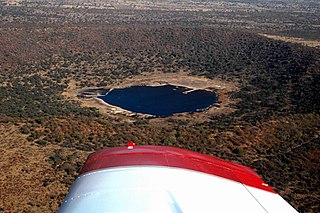
Tswaing is an impact crater enclosed by a 1,946 ha nature reserve, situated in northern Gauteng province, South Africa. The crater and reserve are situated on a base of ancient granite of the Bushveld Igneous Complex, some 40 km to the north-northwest of Pretoria. This astrobleme is 1.13 km in diameter and 100 m deep and its age is estimated to be 220,000 ± 52,000 years (Pleistocene). The impactor is believed to have been a chondrite or stony meteorite some 30 to 50 m in diameter that was vaporised during the impact event. Morokweng impact structure, another South African crater of chondrite origin, lies north-west of Vryburg. Since 1996 it falls under the auspices of Ditsong Museums of South Africa.
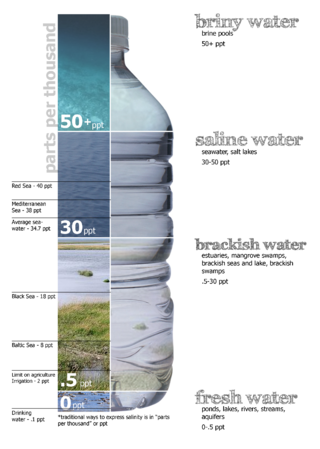
A salt lake or saline lake is a landlocked body of water that has a concentration of salts and other dissolved minerals significantly higher than most lakes. In some cases, salt lakes have a higher concentration of salt than sea water; such lakes can also be termed hypersaline lakes, and may also be pink lakes on account of their colour. An alkalic salt lake that has a high content of carbonate is sometimes termed a soda lake.
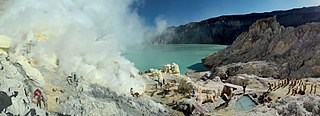
The Ijen volcano complex is a group of composite volcanoes located on the border between Banyuwangi Regency and Bondowoso Regency of East Java, Indonesia. It is known for its blue fire, acidic crater lake, and labour-intensive sulfur mining.
An aquatic ecosystem is an ecosystem found in and around a body of water, in contrast to land-based terrestrial ecosystems. Aquatic ecosystems contain communities of organisms—aquatic life—that are dependent on each other and on their environment. The two main types of aquatic ecosystems are marine ecosystems and freshwater ecosystems. Freshwater ecosystems may be lentic ; lotic ; and wetlands.

Queen Elizabeth National Park is a national park in the Western Region of Uganda.

Lake Assal is a crater lake in central-western Djibouti. It is located at the western end of Gulf of Tadjoura between Arta Region, and Tadjoura Region, touching Dikhil Region, at the top of the Great Rift Valley, some 120 km (75 mi) west of Djibouti city. Lake Assal is a saline lake that lies 155 m (509 ft) below sea level in the Afar Triangle, making it the lowest point on land in Africa and the third-lowest point on Earth after the Sea of Galilee and the Dead Sea. No outflow occurs from the lake, and due to high evaporation, the salinity level of its waters is 10 times that of the sea, making it the fifth most saline body of water in the world, behind Garabogazköl, Lake Retba, and Gaet'ale Pond. The salt in the lake is exploited under four concessions awarded in 2002 at the southeast end of the lake; the major share of production is held by Société d’Exploitation du Lac and Société d’Exploitation du Salt Investment S.A de Djibouti.
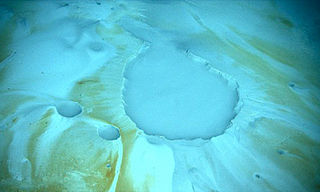
A brine pool, sometimes called an underwater lake, deepwater or brine lake, is a volume of brine collected in a seafloor depression. These pools are dense bodies of water that have a salinity that is typically three to eight times greater than the surrounding ocean. Brine pools are commonly found below polar sea ice and in the deep ocean. This below-sea ice forms through a process called brine rejection. For deep-sea brine pools, salt is necessary to increase the salinity gradient. The salt can come from one of two processes: the dissolution of large salt deposits through salt tectonics or geothermally-heated brine issued from tectonic spreading centers.
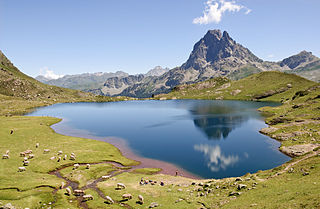
A lake is an often naturally occurring, relatively large and fixed body of water on or near the Earth's surface. It is localized in a basin or interconnected basins surrounded by dry land. Lakes lie completely on land and are separate from the ocean, although they may be connected with the ocean by rivers. Most lakes are freshwater and account for almost all the world's surface freshwater, but some are salt lakes with salinities even higher than that of seawater. Lakes vary significantly in surface area and volume of water.

A hypersaline lake is a landlocked body of water that contains significant concentrations of sodium chloride, brines, and other salts, with saline levels surpassing those of ocean water.

Environmental impact of mining can occur at local, regional, and global scales through direct and indirect mining practices. Mining can cause erosion, sinkholes, loss of biodiversity, or the contamination of soil, groundwater, and surface water by chemicals emitted from mining processes. These processes also affect the atmosphere through carbon emissions which contributes to climate change.

The Katwe craters or Katwe-Kikorongo explosion craters are a group of volcanic craters within Queen Elizabeth National Park in Toro, Uganda. The volcanic field is roughly 210 km2 (81 sq mi) in size. The individual craters vary widely in size, but the largest are up to 3 km (1.9 mi) in diameter and 100 m (330 ft) deep. The unusual formations were formed individually by a series of violent volcanic explosions over the last 1 million years. These maar craters are a result of magma coming in contact with groundwater driving large steam explosions. The explosive events created large, low lying craters with few other signs of volcanic activity.

Lake Pikrolimni is an endorheic, alkaline salt lake in Kilkis prefecture, Greece. It is located on the border of the Kilkis and Thessaloniki regional units, about 40 km northwest of Thessaloniki. The lake is hypersaline, has rather shallow waters (0.5–0.7 m) and a shoreline of about 8.5 km. The water surface area shows significant seasonal variation (3.2–4.5 km2) due to evaporation in the summer months, with an average value of 3.7 km2.

Kitubulu Central Forest Reserve is a protected area located in Uganda, near the city of Entebbe in Central Uganda. Covering an area of 80 hectares, it is an important forest ecosystem that is home to a diverse range of flora and fauna. The reserve is categorized as a Category IV protected area by the International Union for Conservation of Nature (IUCN), indicating its significance for the preservation of biological diversity and the protection of ecosystems. The forest reserve is situated in Central Uganda and is protected by the National Forestry Authority under the National Forest and Tree Planting Act. The forest reserve was gazetted in 1932 to protect Lake Victoria and the environment.

Kyewaga Central Forest Reserve is a forested area located in Wakiso District, Uganda. The reserve is known for its rich biodiversity and ecological significance. However, in recent years, it has faced various threats and challenges, including sand mining, fish ponds, and encroachment by licensed tree planters.
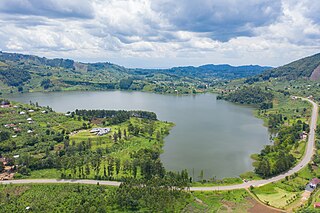
Lake Nkugute, also known as Lake Rutoto, is a lake located in Rubirizi District, Uganda. Situated in the Bunyaruguru volcanic field, the lake is believed to have been formed over 12,000 years ago as a result of volcanic activity. It has become a place of mystery and local folklore, with tales surrounding its origin and behavior.

Lake Mulehe is a crater lake situated in the Kisoro District of southwestern Uganda, close to the border with Rwanda. This lake is a part of the Albertine Rift, which is well known for its biological diversity and visually striking landscapes.
Lake Kijanebalola, also known as Lake Kijanebarola or Lake Kijjanebalola, is a freshwater lake located in Koki county, Kyalulangira sub-county, Rakai District, Central Uganda. Spanning an area of around 14 square kilometers, it contains Kisozi Island and Kinoni Island. The lake is surrounded by populated places such as Lugando, Kisomole, Gombe, Lukondo, Kayonza, Buyanda and Dwaniro.